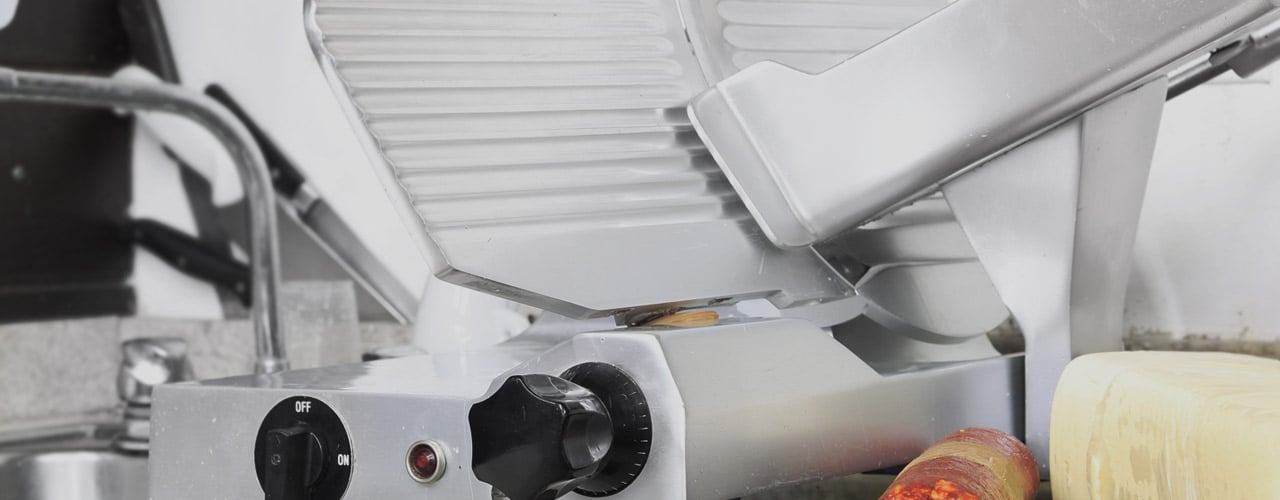
Meat slicers are crucial pieces of equipment for delis, grocery stores, and butcher shops, allowing you to slice meats and cheeses in a variety of ways. When you don't regularly clean your slicer, food residue can build up in different parts of the machine, creating an environment where bacteria can grow and increasing the risk of foodborne illness. This accumulation of food residue can also cause small food particles to transfer from one product to the next, altering the flavor and texture of your foods. We'll outline the proper way to clean a meat slicer below so that you can reduce these risks and guarantee a safe, quality product.
Shop All Meat SlicersHow Often Must a Meat Slicer Be Cleaned?
According to the FDA's food code, contact surfaces on a meat slicer should be cleaned and sanitized every 4 hours and at the end of every shift change to prevent the buildup of bacteria and pathogens. Employees should wipe the unit down when switching between meats and cheeses to prevent cross-contamination. Slicers should also be deep-cleaned and inspected by a trained food handler at the end of every workday to ensure they are in good working condition and free from any potential contaminants.
How to Clean a Meat Slicer Video
Watch the video below for a step-by-step example of how to clean a meat slicer:
Meat Slicer Cleaning Instructions
Meat slicers are complex machines with many intricate parts, and it's important to understand the right way to clean them. If you don't, you risk causing damage to your appliance. We've provided a list of steps to walk you through the meat slicer cleaning process below:
- Wipe the blade: Set your thickness to zero and use a gentle scrub pad to wipe both sides of the blade as the slicer is in motion. Once you have removed any large food particles, turn off and unplug your slicer.
- Wash major components: Set the gauge plate to the fully closed position and remove the sharpening stone. Remove the product tray, slice deflector, and center plate. Wash, rinse, and sanitize these components and let them air dry.
- Clean the blade: This can be done by removing the blade or leaving it in place. Create a soapy solution with a 1:1 ratio of hot water and soap. Alternatively, you can use degreaser spray to clean the blade. Clean both the front and back of the blade while wiping from the center outward.
- Clean exterior: Wipe down the exterior and all remaining pieces of the slicer. Then, rinse with hot water using a clean towel.
- Sanitize: Use a food contact surface sanitizing spray to sanitize the appliance. Use a spray bottle to coat the machine thoroughly and allow it to air dry.
- Lubricate: Using a food-grade spray lubricant, lubricate the slide rods of the slicer. Once the slicer is dry, replace the blade, faceplate, and product tray.
Meat Slicer Cleaning Tips
Proper cleaning and maintenance of a meat slicer is crucial to ensure food safety and extend the lifespan of the equipment. Keep the following suggestions in mind to ensure your safety and success while cleaning your meat slicer:
- Always wear protective gloves: Meat slicer blades are sharp, and gloves will help protect your hands during cleaning.
- Follow manufacturer instructions: Different meat slicers may have specific cleaning instructions provided by the manufacturer. Refer to the user manual for guidance on the recommended cleaning process.
- Avoid using steel wool: Steel wool can scratch the surface of the slicer and damage the blade, compromising its effectiveness and potentially contaminating food.
- Don't submerge your slicer completely: Avoid submerging the entire unit in water or any cleaning solution. Doing this can damage the motor and other internal components of the slicer. Instead, use a damp cloth or sponge to clean the surface of the slicer, paying attention to areas with food residue or buildup.
Meat Slicer Problem Areas
When it comes to maintaining a meat slicer, there are several problem areas that commercial kitchen operators need to be aware of to ensure the slicer operates efficiently and safely. Addressing these issues can help prevent breakdowns and keep your equipment in top condition.
- Damaged components: Carefully monitor the ring guard mount, blade guard, and slicer handle on your meat slicer for any cracks, broken parts, or missing components, and replace them with new meat slicer parts as necessary.
- Accumulated food: Food particles can accumulate in and around certain parts of your slicer, allowing bacteria to breed.
- Broken seals: Regularly examine seams, seals, and gaskets to see if they've worn away. If you discover damage, remove the slicer from service and repair it.
How to Sharpen a Meat Slicer Blade
To maintain productivity and ensure the highest quality of sliced meats, you should regularly sharpen the blade of your meat slicer. When sharpening the blade, it is crucial to prioritize safety by wearing cut-resistant gloves to protect your hands from potential injuries. Most meat slicer units feature a built-in sharpening stone, making the sharpening process convenient and efficient.
- Unplug the meat slicer and thoroughly clean the blade on both sides to remove any food residue or debris.
- Loosen the sharpener knocking knob and rotate it until the blade is between the sharpening stones. Once the blade is in place, securely retighten the pin to ensure stability.
- Plug the meat slicer back in and turn the power on.
- Follow the manufacturer's instructions to operate the sharpening button on your unit. Repeat this process as directed until the blade is sharp and effectively restored to its optimal cutting condition.
- Once the blade is sharpened, return the meat slicer to its original state. Reassemble and secure all components.
Back to Top
Because meat slicers are used so frequently, they must be cleaned regularly. Be sure to regularly inspect your machine for any damaged components or food buildup, and immediately perform maintenance or clean the machine if any is found. When you're consistent with meat slicer maintenance, you can increase the lifespan of your unit and reduce the chances of contaminating food.





